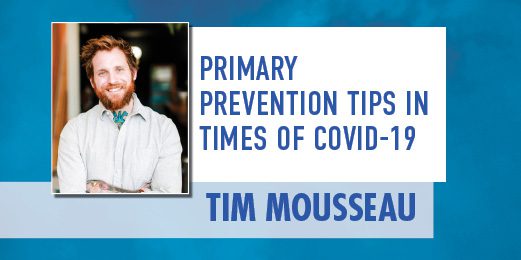
Primary Prevention Tips in Times of COVID-19
When COVID-19 hit near the start of April, right at the beginning of Sexual Assault Awareness Month, I found most of my conversations with campus partners centered around the resounding question, “What now?” For many of us, there seemed to be this hope that the fall would offer a return to past plans with the adoption of some shiny, new virtual tools that made life easier. Although we’re almost five months removed from then, I doubt many of us involved in Primary Prevention thought the future might look like this.
When you mix an increasingly stressful world environment, an unhealthy degree of uncertainty, and a public health crisis, the result is an exceedingly difficult conundrum. And despite any breathing room, there is not new normal as expectations and policies are shifting on a moment’s notice.
I stand behind the idea that Primary Prevention has a place during this time. Things are different, but our impact can remain. The following tips are centered around what seems to be working. Although the following tips will be grounded in what I am seeing from a Sexual Violence Prevention standpoint, many of these can be applied to other areas of Primary Prevention.
Make Small Efforts
Our audiences and communities are over engaged. From all reports, screen time has shot up drastically throughout the last few months. Even if students are returning to campus, as hybrid models are utilized, virtual fatigue set in a long time ago.
Whether in-person or virtual, make sure that your efforts are small. Whether it’s 10 to 15-minute microprograms, videos that focus on one concept, or targeting one specific population on a defined issue, less can do more.
Don’t Shy Away from Reality
The reverberations of this time period already are and will continue to echo for quite some time. Some of these reverberations are known; for example, incidents of domestic violence have increased in this time. Other impacts may take time to recognize.
Our current pandemic is changing the way people are learning as well as the type of information they need. For another example, right now it is foolish to talk about consent without recognizing how virtual relationships enact and change this concept.
Prevention doesn’t exist in a bubble. Do not be afraid to recognize this.
Plan Resource Accessibility
I always ask that a campus provides counselors for my sessions due to the nature of the topic. Virtually, this looks a little different. Sometimes this can mean having counselors on a webinar with me. Other times, this means that contact information hasn’t been updated or that the way to reach counselors is impossible to post without compromising their personal safety. It might mean hours or processes for booking appointments have changed. There are a multitude of ways that accessing this one resource has shifted.
Our students are still searching for resources, and we should never serve as a hindrance. It is important to ask what your most frequented resources are and how you can or have tweaked this information to meet remote conditions.
Collect Data
Now is a great time for assessment. One of the main reasons prevention campaigns fail is they focus on the wrong issues or they focus on too many. When it comes to planning, take a step back and decipher if we are working on the right issues. From formalized assessment to less formal surveys or focus groups, spend now reassessing needs.
Record Everything (That You Can)
Where appropriate, record and keep records of everything. During this time, needs are constantly shifting. People are exhausted. Creating content can also be exhausting. Where possible, keep recordings.
This is especially helpful with video training. If you have a recording handy, it can help you reach new audiences. Once you’ve shot a webinar or video once, it also makes the matter less taxing on you to tweak, host, and distribute the recording instead of having to do it a second time.
